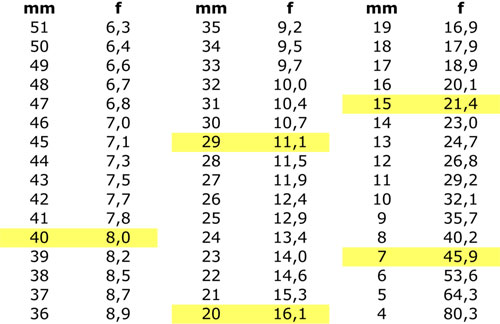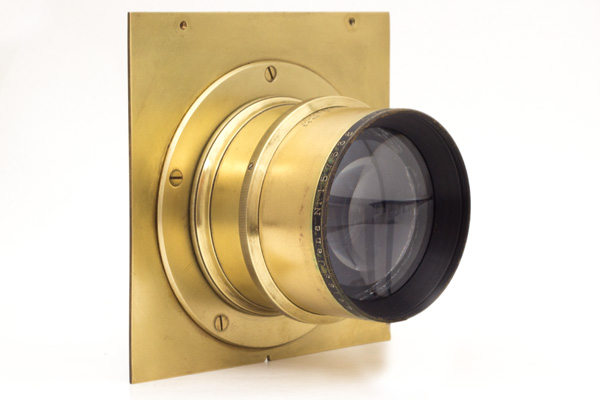
– 360 mm | f:6,3 | 1911 –
The very first Tessar
Tessar is probably the lens design most produced ever. Introduced in 1902, it was created by Paul Rudolph, from Carl Zeiss. The construction concept has found applications from large format down to Minox size. Lenses using Tessar’s design reached the order of millions of units and equipped all kinds of cameras. Until today, the same basic design can be found in lenses used in smart phones. Maybe you have a Tessar and just don’t know it.
In terms of filiation it was a rather fast rollout of ideas introduced with the remarkable Protar (formerly named Anastigmats, launched in 1890, by the same Carl Zeiss) and the Unar (also Zeiss design). Protars have symmetric cemented groups on both sides of diaphragm, 2, 3 and even 4 glasses each side, that is the case of Protar series VIIa, and were the first ones to correct astigmatism while offering apertures as large as f7 and more. Unars were also symmetric, corrected and used air spaced doublets on both sides of diaphragm.
Tessar, named after the Greek word τέσσερα, téssera, that means four, for four glasses, has two air-spaced elements in front of the diaphragm. Those are very weak in power and their role is related to helping in aberrations reduction. The rear glasses are cemented and are the ones with convergence power to form image. Maybe foreseeing the bright future for this new lens, from 1906 onwards, Carl Zeiss adopted a company logo designed after the Tessar rear doublet.
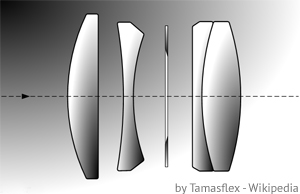

The virtue of this lens is that it has a relatively simple construction and delivers a very sharp image throughout the film plane even in the lower range of f stops. Being simple and with few air/glass surfaces it gives less opportunities for flare. That was important as lens coating was not yet available. In practical terms it could compete with other Anastigmats, far more expensive, and yet satisfy the most demanding photographers.
The lens shown above, in brass barrel, is a vintage Tessar in its very first version with max aperture f/6.3 and impressive 70º coverage. It was produced in april/1911 (information based on its serial number 157538). The illustration below, from Zeiss Archive shows exactly this Tessar version.
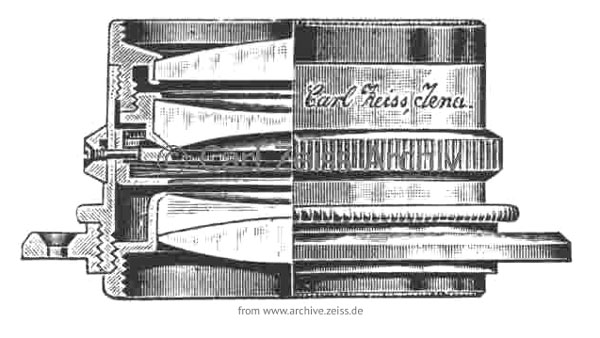
Many variations and improvements were made in subsequent decades. According to Lens Collectors Vade Mecum there was a f4.5 already in 1906 designed by E.Wandersleb. Later, in 1930 it went up to f/2.8 with new design by W.Merté and E.Wandersleb. Some versions for movies and projection, were even faster.
Here is an account of the first 5 years, published by Josef Maria Eder in ‘Journal of Photography and Photography Reproduction technique for the year 1907’ (Jahrbuch für Photographie und Reproduktionstechnik für das jahr 1907):
“In 1902 Zeiss applied for a patent of its Tessar type lens. His inventor, Dr. Paul Rudolph, proposed it initially in two versions, the Tessar 1: 6.3 as a universal objective of medium luminous intensity, and the Apochromat -Tessar 1:10 to 1:15 as a reproduction objective […] Both series have become, each in their own domain, very popular. Wandersleb tried, for the already launched series, improve its advantages with brighter Tessar lenses. The investigations which he undertook in this direction were successful and led to the construction of Tessars 1: 4.5 and 1: 3.5. These are recently released by the Zeiss works as series Ic in addition to the Tessars 1: 6.3 [series IIb].

The Tessar is well suited for tri-color photography from nature. The Tessar 1: 4.5 (Fig. 107), as well as the Tessar 1: 6,3, is as completely distortion-free as good as any other luminous symmetrical anastigmat [Protar, Planar and Unar for instance]. Wandersleb stresses this because publications on symmetrical lenses, especially in brochures and expert opinions, it is assumed that symmetrical construction eo ipso [by itself] abolishes distortion. This view is incorrect. It is valid only if the image through the lens is life size, a case which occurs, except in reproductive photography, almost never. Most of the photographs, especially with the hand-held camera, are close to the other borderline, namely, that the object lies at infinity and therefore in scale 1:∞. In these cases the symmetry fails as a means of complete orthoscopy [distortion free image].
The new and brighter Zeiss Tessars, series Ic, 1:3,5 and 1:4,5, have the same construction type. Only four lenses are used; Two of which are cemented to one another, and the remaining two are separated by air. The lenses are designed for portrait shots, cinematographic recordings and three-color photography. The Tessars of brightness 1: 4.5, like the Unar, have an image angle about 50º degrees.“
50º for Ic compared to 70º for series IIb – as it always happens in lens design, the gain in luminosity had to compromise with something else, in this case, the it was the angle of view. In the Lens Collectors Vade Mecum it is ventilated that Zeiss would have rather focused more on its recent developments and keep the Tessar for a future deployment, they were not searching substitutes for their more complex Anastigmats. But Tessar’s quality quickly made it a photographers’ choice.
“There is a hint that the success of the Tessar came as a slight surprise and that the response took a little time in preparing a faster version. Remember that Zeiss introduced the f4.5 Anastigmat, Planar and Unar in succession over some 10 years and may have wanted more continuity at this aperture! The f4.5 Tessar was to be a product that put all of them in the shade. Compared with the f6.3 it was faster and more successful, though connoisseurs say it just is not quite such a charismatic item! But it did replace both the f4.5 Unar and the Planar.“
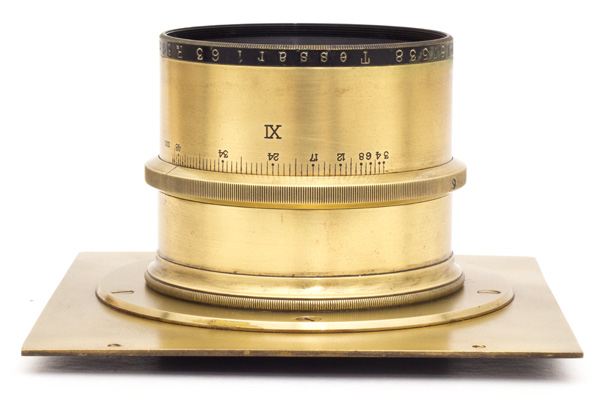
Tessar Série IIb – 360mm f/6.3
The early Tessar 360mm, as mentioned above, has impressive 70º angle of view. That calculates an image circle of 50,4 cm (~20″). Considering that a full plate (18 x 24 cm) demands only 30 cm image circle and an 8 x 10″ requires ~13″, it is clear that it guarantees a lot of movements even with such big negatives. It was named Tessar IIb and marked as XI. Lens diameter is 61 mm. Lens is 74 mm tall.
At the beginning the new IIc series was produced in 40, 56 ,84, 112, 136, 145, 155, 180, 210, 255, 305, 365, 490, 590 mm focal length. Later, the 56, 112, 136,255, 305 and 365 were rounded to 55, 120, 135, 150, 250, 300 and 360 respectively.
Below is a portrait made with fully open lens aperture and a Guerry shutter was employed (speed around 1/4 s). What is worth noting is that at the same time we can se the texture of fabric at the very bottom left, we can count the sitter pores at the central part of image and hairs at the mid upper part. That is what an Anastigmat is supposed to do and the Tessar, from this very first version, was capable to accomplish that, even when fully opened. Before anastigmats, any lens had a blur more or less accentuated out of image’s central portion, no matter the distance subject to lens and the only remedy to fix it was to stop it really down.
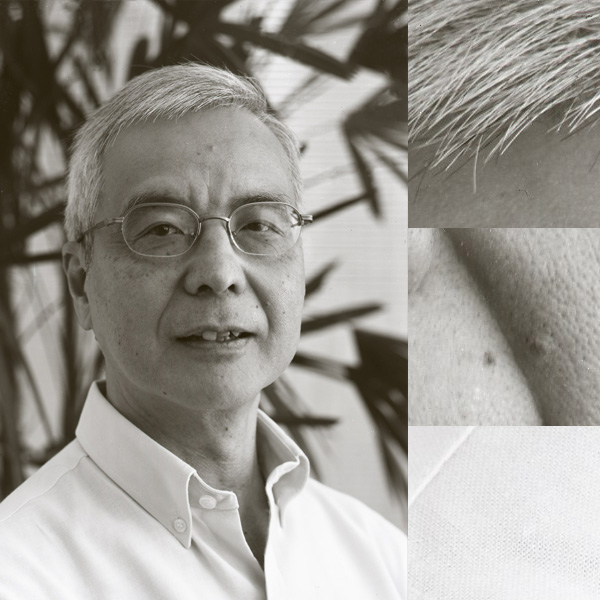
This lens has a specific feature. The aperture scale, instead of showing any of the nowadays regular f stops figures, like f8, f11, f16, f22… shows the iris diameter in mm. It goes from 3 to 51 mm, one by one, being 48 the last one in written. Dividing 360 mm by f6.3 we get 57 mm, after the aperture formula. That is the actual entrance pupil as I confirmed by measuring it. That means from iris to entrance pupil there is a gain of ~12%. I used the same proportion to translate every millimeter mark into its correspondent f stop. There is a table at the end of this article.

Mounted in a Thornton Pickard Royal Ruby, the one used for the above full plate (18 x 24 cm) portrait, in a shutter of the same brand. But I mounted a Guerry shutter in front of the lens in order to get a slower speed as roller blinds of this sort cannot offer 1/4 s. The brass lens board is a homemade 13 x 13 cm that conveniently fits also in a Linhof 13 x 18 cm.
Tessar Ic f/4.5
Large format Tessars were produced for many decades. Assuming that one interested in Tessars is looking for sharpness and distortion free images, for current use, the coated ones are highly desirable items. This one, according to its serial number, was produced from 1961 to 64. It is relatively easy to find and normally a low priced lens due to its availability. An excellent pick to start in large format.

The picture below was taken with this lens. It is Hamburg’s town-hall. It was about 15 seconds, f11 exposition on Agfa 100, 13×18 cm developed in 510Pyro. Camera was a solid Linhof Technika mounted over an also heavy duty Gitzo tripod.

To my quality standards, I consider this a superb image in terms of detail and contrast. Of course film/ developer/ luck play a role in there. Even the atmosphere, that was so clear and dry, helped in getting this end result. But certainly none of those could make up for a low quality lens.
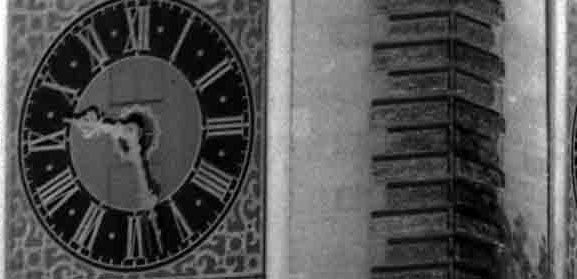
Front glass diameter is 52 mm. Filter diameter is 67 mm and lens is 51 mm tall. Apertures from f4,5 up to f32. The coating has a bluish tone and I believe it is single coating.
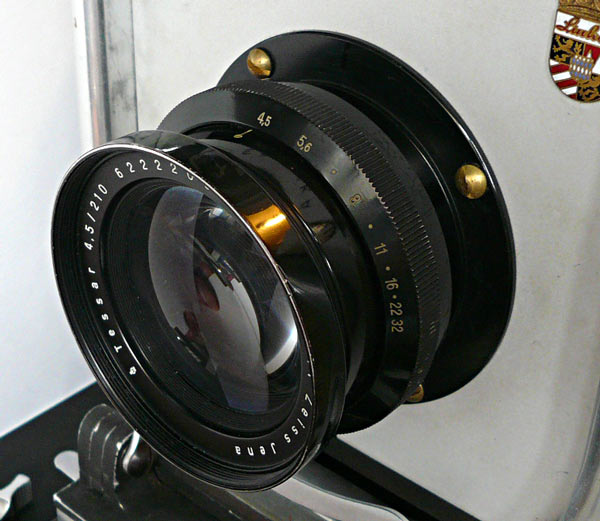
Tessar embraces all formats and systems

As we go further into XXth century the varnished brass barrel yields almost completely to black or silver finish. This is a Carl Zeiss Jena – Tessar 1:4,5/210 mm from 1928. Front lens diameter is 49 mm, largest barrel diameter 74 mm , lens is 49 mm tall. Apertures from 4.5 to 32. Serial number 914226. There is a BVI inscription on aperture ring that so far I was not able to find what it means. It came in a Graflex Auto BR and that is the reason why it has a recessed barrel letting only a small part protruding out of lens board. Fitted in a Auto RB it makes a nice combination for portraits on 9 x 12 cm film, for which a 150 mm would be the standard lens.
If you go on noticing, you will see that a great many folding cameras from 20′ and 30’s, a sort of hybrids between view and handheld cameras, used Tessars. The Nixe B, below, produced by ICA, part or Zeiss conglomerate, is a typical example, it was able to shoot with roll film and also plates (8 x 14 and 9 x 14 cm, respectively) and used a Tessar f4.5 150 mm mounted in a Compur shutter.

Also early Rolleiflexes used a Tessar as taking lens. This model is referenced as 622, has a Tessar f3.5 75mm and was produced between 1932 and 1938. The same camera with Tessar f3.8 and f4.5 75mm were also available. According to the Rolleiclub, only for this camera, ~95.000 Tessars were produced.

Super Ikontas (below), were launched by Zeiss Ikon in 1934. Most of them were equiped with a Tessar lens (Novar and Xenar were also used) fitted for 3 different frame sizes in 120 film: 4,5 x 6 cm, 6 x 6 cm and 6 x 9 cm. Named as A, B and C Super Ikontas, respectively. Tessar lenses were f3.5 for A and C, and f2.8 for the B size. According to Zeis Compendium East and West – 1940-1972 this lens was “regarded as a trifle soft at full aperture”. Also in the Lens Collectors Vade Mecum we find an observation about the 1931 design made by Merte that corroborates this information: “It is fairly common and usually really good but the original 80mm version for the 6×6 cm Super Ikonta seems to be somehow different and is less liked by users”. Later, in the same Vade Mecum, we read that the version redesigned in 1952 “was well ahead of the old f2.8 Tessar used on the pre-war Super Ikontas”.

I used quite a lot both, pre and post 1952 designs. I think none of them are up to the standards of Tessars I used in other cameras. Having said that, it is not a lens that deceives and sharpness is not everything in a photographic image. The camera itself is a nice travel companion. Very small for a medium format although heavy with its metal body. Bellow is a B&W toned picture from Seringeti, Tanzania, and another one from Paris, France. It is not for comparison as that would be impossible with completely different pictures, but for the sake of information, the first one was made with an old uncoated Tessar and the second one with a newer and coated Tessar.


In 35mm the Tessar is a very good option and indeed equipped probably millions of cameras, from very simple ones like this Contessa 35 – Zeiss Ikon to futuristic experiments like the Werra also from Zeiss Ikon. It is a general purpose lens that matches very well the point & shoot spirit of these cameras.
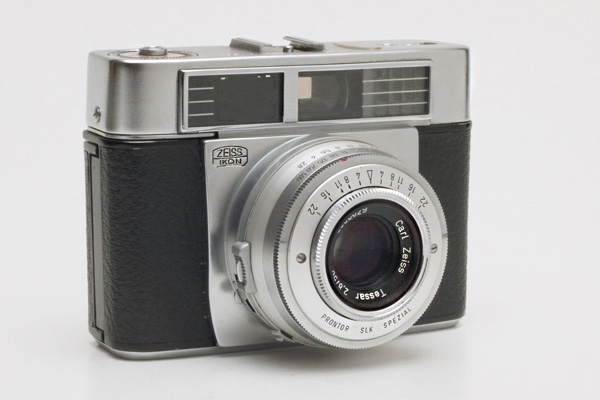
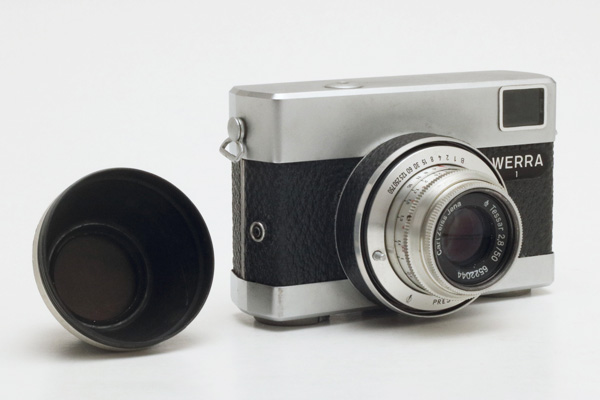
This picture was taken with the Werra and illustrates how a Tessar, in a camera like this, is aimed to simply faithfully capture the subject. It was shot fully open at f2.8. Leica cameras, by all means an intuitive and kind of “decisive moment” image capturing device, used the Elmar, from Leitz, that is also a Tessar type construction.

In more sophisticated single lens reflex cameras, with better focus capabilities, one can think of a Tessar aiming for bigger enlargements. This Contaflex Super BC is famous for a redesigned Tessar capable of very contrasty and crispy images.
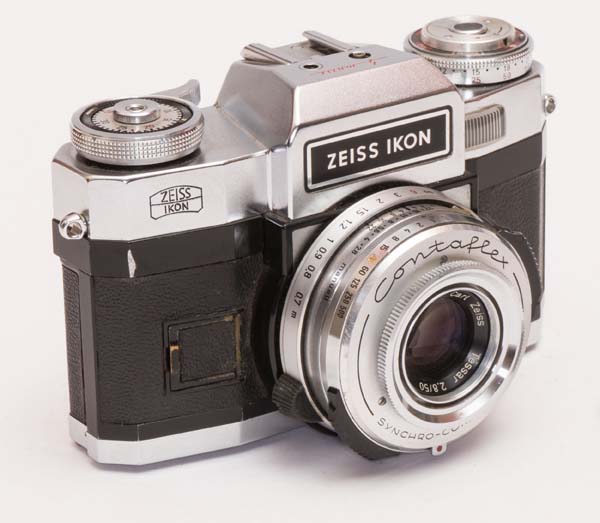
The front element can be replaced and different focal lengths are by this way obtained. A set of Pro-Tessar front elements supply options of 35, 85, 115 mm.

Picture below were taken with the standard f2.8 50mm in Freiburg – Germany. To be noticed how the leaves lit by sunlight and positioned agains a dark background do not have noticeable halo. The texture of tree trunks and floor are evenly rendered throughout the film plane.
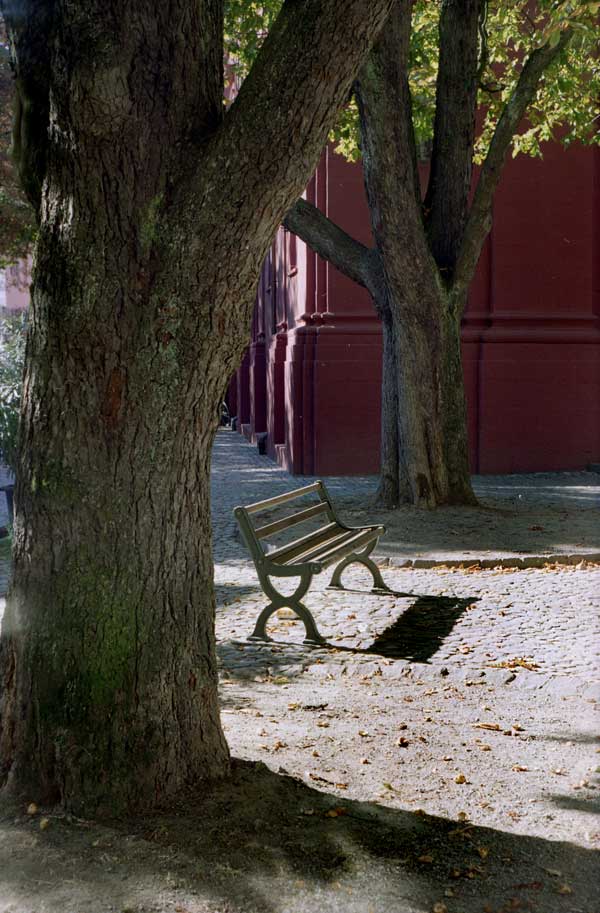
Well this was just a quick look into the birth and history or Tessars. The aim was about giving a feeling of how versatile and successful this lens design was. For a more comprehensive listing a good reference is the above mentioned Lens Collectors Vade Mecum. The Zeiss Archive (in German) is of course an excellent source but I think it is more intended f0r researching specific items instead of providing a landscape view.
All in all this it is a real classic. Being very common and not expensive, people more often go mentioning fancier, rarer and more complicated lenses, not the one that was fitted in so many amateur cameras. It is a kind of lens that gives priority to the subject. It is not intended to have a “signature” or introduce any soft focus special effect. It is simply constructed to give a faithful, true to life, image of what the photographer had in front of his eyes. A lens for “straight photography”.
The success was so big that Zeiss Ikon licensed many manufactures to produce Tessar’s design. Below is an ad from Bauch & Lomb featuring the Tessar Ic. That was published in Photominiature may/1910. To be highlighted that it talks about “covering power” for a lens with 50º angle of view and “softer effects” for an anastigmat designed to be sharp. That means that back there in 1909 one should not be so confident in advertising claims.
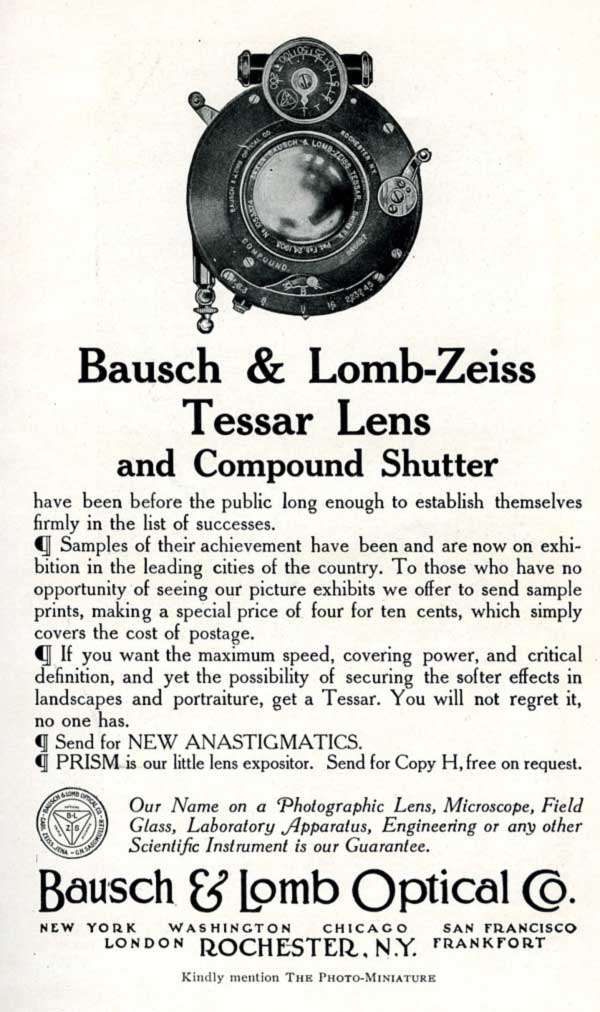
In the same magazine, now in September 1914, the attributes are focused in “home portraiture”.
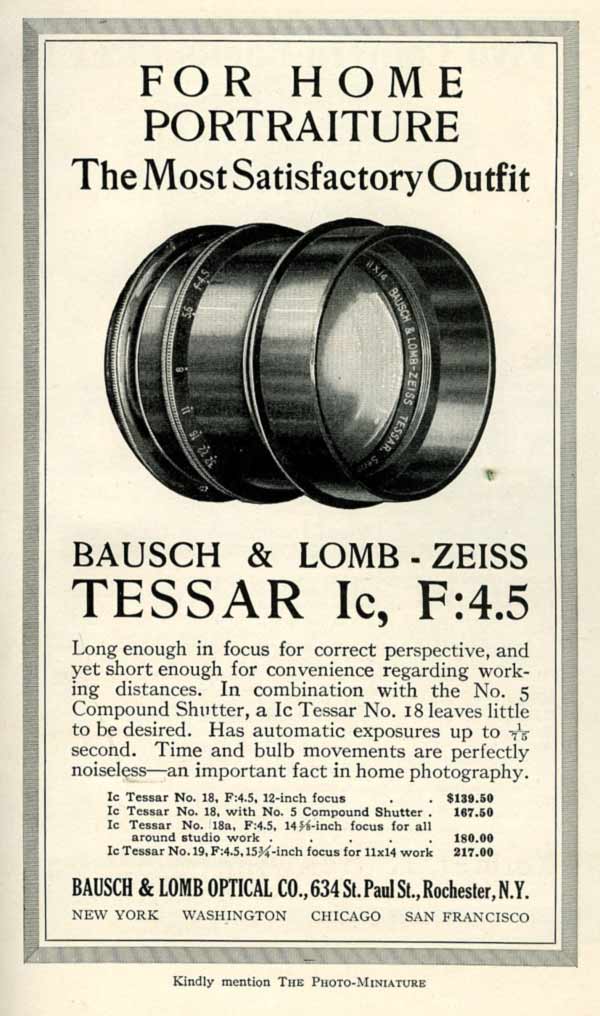
Tessar were also copied and adapted into other brand names. Kingslake provides a list of lens makers and lenses using the Tessar design:
Agfa: Solinar
Berthiot: Flor, Olor
Boyer: Saphir
Busch: Glyptar
Dallmeyer: Dlamac, Perfac, Serrac
Ernemann: Ernon
Hermagis: Hellor, Lynx
Ilex: Paragon
Kodak: Ektar
Laack: Dialytar
Leitz: Elmar, Varob
Meyer: Primotar
Plaubel: Anticomar
Rodenstock: Ysar
Ross: Xtralux
Roussel: Stylor
Schneider: Comparon, Xenar
Taylor-Hobson: Apotal, Ental
Voigtlander: Heliostigmat, Skopar
Wollensak: Raptar
Wray: Lustrar
As a closing, an advertising of a distributor of Zeiss lenses, E.B.Merowitz, also in Photominiature, December 1909, featuring this time the series IIb.
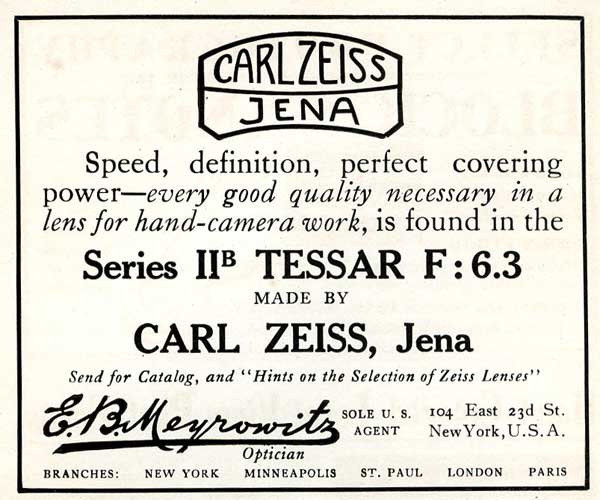
Apendix
Table conversion mm to f stops for Tessar IIb – 360 mm
